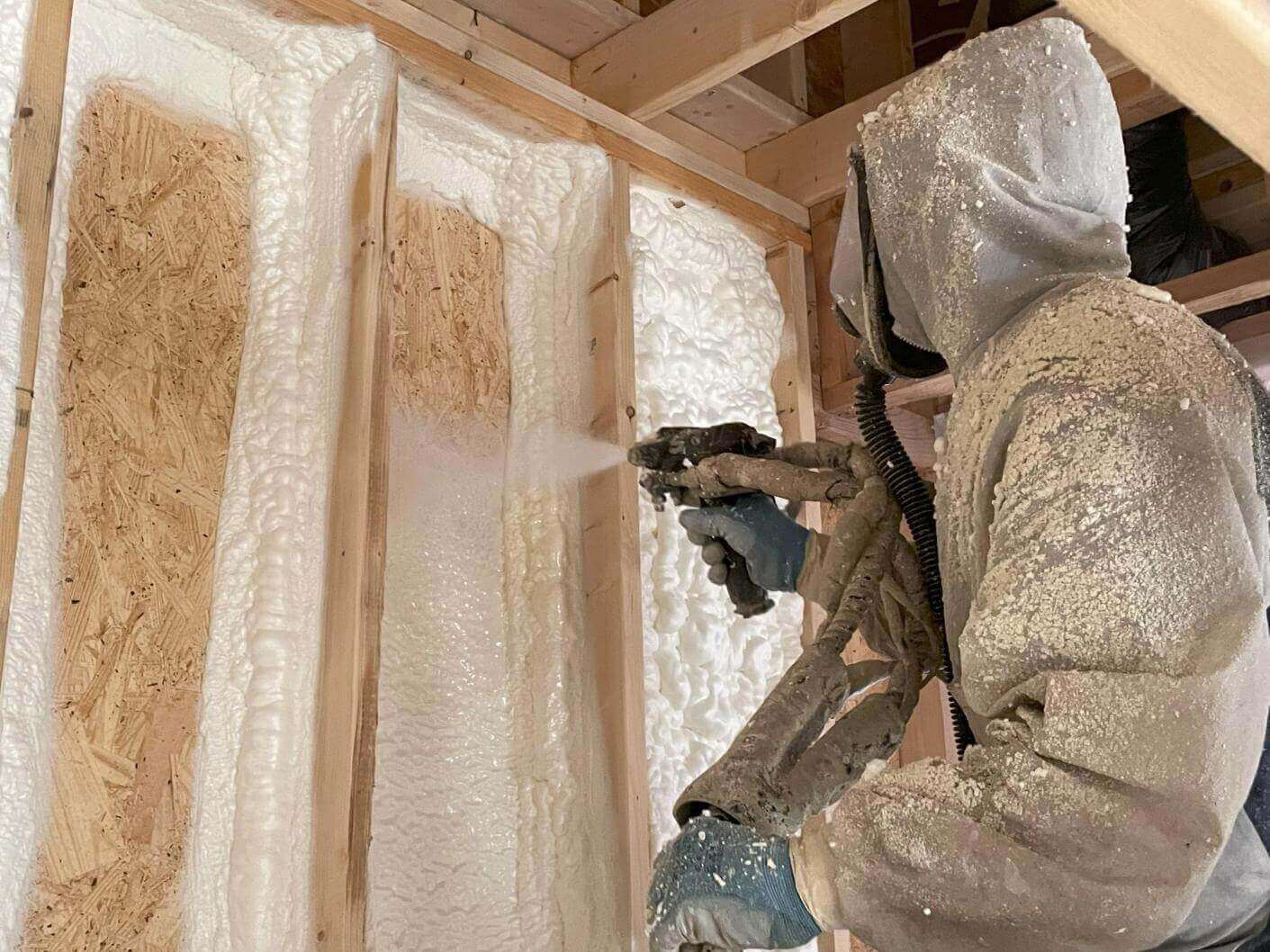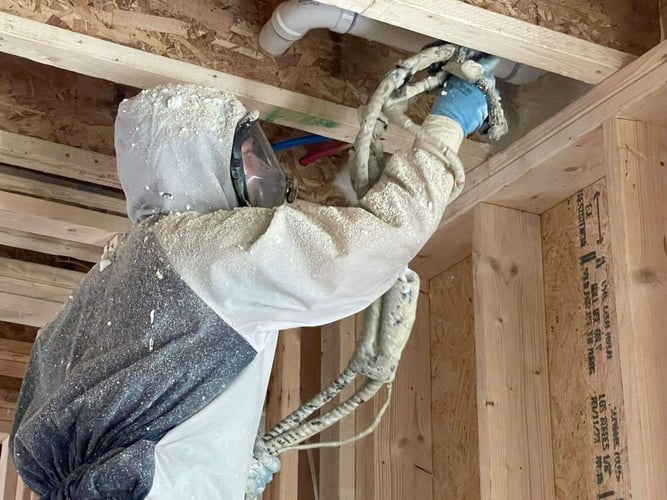Tips for Maintaining Your Spray Foam Insulation for Long-Term Efficiency
Tips for Maintaining Your Spray Foam Insulation for Long-Term Efficiency
Blog Article
How Spray Foam Can Enhance Power Efficiency in Any Kind Of Structure
Spray foam insulation has become a pivotal service for enhancing energy efficiency across various structure kinds. By developing an airtight seal that decreases air leakage, it efficiently controls interior climates while substantially lowering cooling and heating costs. Furthermore, its remarkable R-value and moisture-resistant buildings add to long-term energy financial savings and boosted structure long life. As building owners progressively seek sustainable solutions, the implications of spray foam insulation prolong past mere energy financial savings. The full range of its benefits, nevertheless, warrants a more detailed evaluation of exactly how it can change power management approaches in both commercial and household setups.
Comprehending Spray Foam Insulation
Spray foam insulation is significantly identified for its superior thermal performance and versatility in numerous applications. Made up mainly of polyurethane, this insulation product is used as a liquid that broadens upon get in touch with, filling spaces and producing a seamless barrier. This distinct building allows spray foam to adapt uneven surface areas, making it an ideal choice for both household and industrial frameworks.

Application of spray foam insulation is typically performed by experienced specialists making use of specialized tools, making sure optimal performance and safety - Spray Foam. The healing process is quick, permitting fast installation and minimal disruption. Therefore, spray foam insulation is significantly being used in new building and retrofitting projects as a result of its capacity to enhance structural stability while boosting total energy effectiveness in structures
Advantages of Power Performance
Energy effectiveness plays a critical function in reducing operational expenses and decreasing ecological impact throughout various sectors. By enhancing power usage, property owners and services can achieve substantial cost savings on utility costs, which directly enhances monetary efficiency. Reliable energy intake indicates much less reliance on fossil gas, therefore adding to a reduction in greenhouse gas discharges and promoting a much more sustainable setting.
Furthermore, energy-efficient buildings usually experience boosted home worths. As energy costs climb and sustainability becomes a concern for customers, buildings with boosted energy efficiency attributes are much more attractive on the marketplace. This pattern encourages financial investment in energy-saving technologies, which can further drive advancement and financial development.
Along with financial and ecological benefits, power performance can also boost the general convenience and health of indoor areas. Proper insulation and effective cooling and heating systems aid keep consistent temperatures, minimizing drafts and moisture levels, which consequently can lead to far better interior air high quality.
Eventually, the advantages of power performance extend past prompt savings, cultivating a resistant economic climate, promoting ecological stewardship, and boosting the quality of life for residents in any structure.
Exactly How Spray Foam Functions
Typically used as a liquid, spray foam expands quickly upon call with surface areas, creating a solid barrier that successfully secures splits and voids. This distinct building is due to its chemical structure, mostly being composed of isocyanates and polyols, which react when mixed to develop a foam that fills up gaps and adheres to various products, including concrete, metal, and timber.
Once applied, the foam expands to numerous times its original quantity, ensuring a tight seal that prevents air leakage. This process substantially minimizes thermal connecting, which happens when warm transfers via products, leading to power loss. The foam's high R-value, a step of thermal resistance, contributes to boosted insulation by minimizing warmth transfer between the interior and outside settings.
Furthermore, spray foam is resistant to wetness and bugs, additionally improving its efficiency in maintaining power performance. Its application can be tailored to various areas, consisting of attic rooms, wall surfaces, and crawl rooms, enhancing insulation throughout a structure. Spray Foam. Overall, the ingenious style and application technique of spray foam make it an efficient option for enhancing power efficiency in any type of structure, leading to decreased energy prices and a much more lasting constructed environment

Applications in Different Structures
Many applications of spray foam insulation can be found throughout various building kinds, improving power effectiveness and comfort. In domestic homes, spray foam is frequently made use of in attic rooms and walls to develop a smooth obstacle versus air leakages, dramatically reducing heating and cooling down needs. This application is especially see post valuable in older homes, where standard insulation may be poor.
In commercial structures, spray foam insulation is related to roofing systems and outside walls, which helps to boost thermal efficiency and safeguard versus moisture intrusion. Its lightweight nature makes it an optimal option for retrofitting existing structures without adding considerable weight. In addition, spray foam can be utilized in commercial settings to protect pipes and tank, keeping temperature control for delicate products.
Institutional buildings, such as colleges and hospitals, benefit from spray foam insulation by guaranteeing a regular indoor climate that supports passenger comfort and health and wellness. The adaptability of spray foam permits it to adjust to numerous structure sizes and shapes, making it a recommended selection for designers and building contractors looking for efficient insulation remedies. In general, spray foam insulation functions as a vital part in attaining energy-efficient structures across all fields.
Long-Term Cost Financial Savings
Spray foam insulation uses considerable lasting price savings for structure proprietors and owners by lowering power intake and reducing utility expenses. By offering an exceptional air seal, spray foam decreases the seepage of outside air, consequently enhancing the thermal performance of a building. This causes more reliable heating and cooling processes, which can result in considerable reductions in power expenses with time.
Along with instant savings on utility expenses, the resilience and longevity of spray foam insulation add to its monetary benefits. Unlike standard insulation materials, which might droop, settle, or weaken, spray foam preserves its effectiveness for years, reducing the need for regular substitutes or repairs. This long life converts to lower maintenance prices and less interruption for passengers.
Additionally, buildings geared up with spray foam insulation commonly delight in an increase in residential property value, making them a lot more appealing to possible purchasers or lessees. As energy efficiency comes to be increasingly prioritized, buildings with efficient insulation remedies stand out in the market. Inevitably, the assimilation of spray foam insulation not only enhances comfort yet likewise represents a tactical investment that generates significant economic advantages over the long-term.
Final Thought
In conclusion, spray foam insulation acts as a crucial element in enhancing energy performance throughout diverse building types. Its capability to create a smooth obstacle against air leakage, integrated with moisture-resistant buildings and high r-values, considerably lowers energy consumption and associated prices. The implementation of spray foam not only adds to consistent indoor temperatures however additionally raises home worth, underscoring its role as a sensible investment for both household and business buildings.
Spray foam insulation has actually emerged as an essential remedy for boosting energy effectiveness across various structure types. Spray Foam. As a result, spray foam insulation is increasingly being utilized in brand-new building and construction and retrofitting projects due to its capacity to enhance structural honesty while boosting general power efficiency in structures
On the whole, the cutting-edge design and application approach of spray foam make it an effective remedy for enhancing energy performance in click to read any kind of framework, leading to minimized energy expenses and a much more sustainable developed environment.
Numerous applications of spray foam visit homepage insulation can be found across different building kinds, enhancing power effectiveness and comfort.In final thought, spray foam insulation offers as a vital element in enhancing power effectiveness across varied building kinds.
Report this page